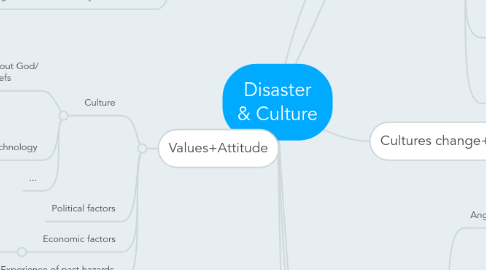
1. Why human/Org. fail?
1.1. Clash of priotities: disaster = org. (people think nothing can be done) VS everyday needs/danger and better livelihoods = people
1.1.1. a clash of cultures: between the disaster agencies who can only see the significance of the hazards and the people whose priority is livelihoods.
1.2. the communicators did not attempt to take the local culture into account
1.3. Key concepts were used in a language that was unfamiliar to the people
1.4. DRR interventions fail to take adequate account of the cultural behaviours that often lead to people having different rationalities.
1.4.1. intervene and inform people for disaster preparedness requires the people to abandon ‘irrational’ ideas they share and have held in good faith for a very long time
1.5. People (due to their beliefs/ socio-economics needs) do not abandon their home/livestocks and risk losing their livelihoods + Belief in traditional warnings
1.6. Making their own "outsider" assumptions abt fatalism
1.7. Staff can't make use of their knowledge about local beliefs
1.7.1. the organization’s logic and priorities don't accommodate different beliefs/priorities.
1.7.1.1. The grass-roots knowledge fades at higher levels of the org’s administrat., where decisions r made within the org’s own ‘culture’, involving financial, logistical and donor constraints.
2. Values+Attitude
2.1. Culture
2.1.1. Beliefs about God/ Local Beliefs
2.1.1.1. If such beliefs and responses are not taken into account, people’s willingness to support other forms of disaster preparedness is likely to be constrained.
2.1.1.2. relevant to how disaster preparedness and climate adaptation is carried out
2.1.2. Belief inTechnology
2.1.3. ...
2.2. Political factors
2.3. Economic factors
2.3.1. Development
2.4. Experience of past hazards
3. People's vulnerability
3.1. disasters are not ‘natural’ but are a product of how human systems make people vulnerable
3.1.1. Disaster =Social construction
3.2. determined by...
3.2.1. factors of politics (how well gov. functions + how power is used to benefit all citizens
3.2.2. economics (how income+assets r distributed+taxes used 4 preparedness)
3.2.3. society (whether some pp r suffering discri.tion on gender or ethnic basis)
3.3. For vulnerability reduction and increased preparedness to succeed, it must overcome the factors that generate vulnerability.
4. Culture + Beliefs of societies
4.1. Angry God
4.1.1. people resisting evacuation
4.1.2. enable people to live with risks and make sense of their lives in dangerous places
4.2. unequal power relations
4.2.1. Culture itself can enable some people and groups to have more power.
4.3. embedded in power that refuses to accept scientific evidence
4.4. prevent or produce risk increase/decrease vulnerability
4.5. affect how people perceive, prioritize risk and how they relate to other people when dealing with risks
4.6. powerful forces for influencing individual and group decisions, livelihoods, lifestyles and attitudes
4.7. Beliefs = part of the process to reduce the cognitive dissonance (=disagreement ideas) with living at risk =outside of people’s own control, but has other sources of control (god, spirits, technology)
5. Org.'l Culture
5.1. Does their definition of problems and solutions fit with the cultures, lives and risk behaviours of the people they intend to help? -a culture of working - a view about disasters and risk that may not be the same as those of the people.
5.2. beliefs and assumptions, the framings and logics.
6. Cultures change+evolve
6.1. Opportunities for compromise exist/ possible to work with people’s beliefs to bring greater safety
7. Strategy
7.1. cooperate with local religions and beliefs, incorperate culture
7.2. Change attitudes
7.2.1. make people aware of disaster
7.2.2. theological debates which accepted that biblical belief was not incompatible with taking action to deal with observable risks
7.3. long-term -> increasing resources, influence, trust and legitimacy as a disaster responder and building coalitions with other actors
7.4. Self-Analysis: reflect on their own way of doing things and their internal culture
7.4.1. Acknowledging (and where possible working with) people’s beliefs
7.5. recognize diversity
7.5.1. not everyone who belongs to a religion will follow its doctrines completely and not everyone belonging to a religion acts the same.
